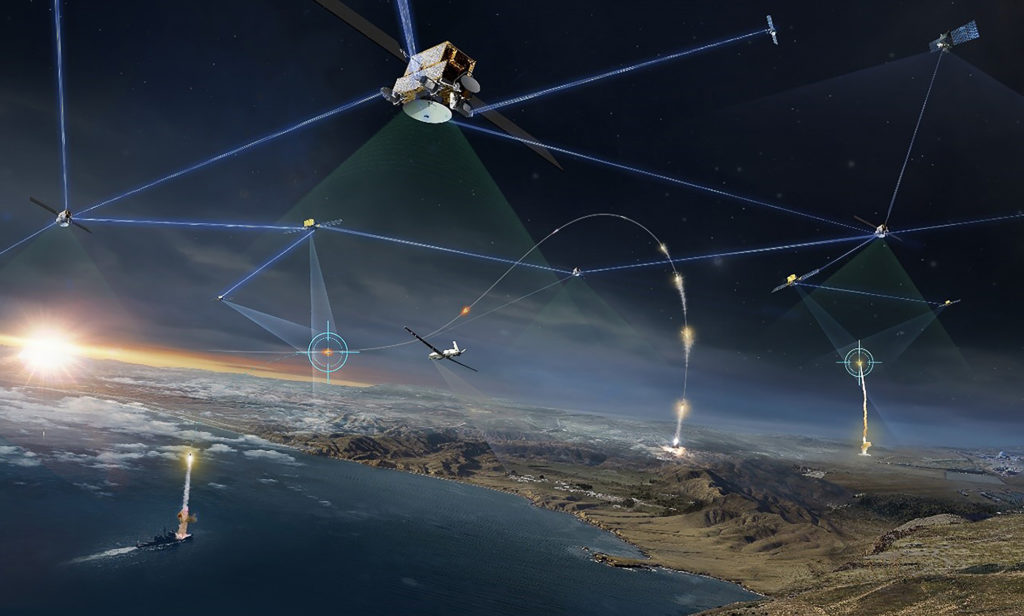The intelligence community is increasing and improving its collaboration with the Space Force, U.S. officials said this week—indicating progress after months of discussions on how to sort out roles in the rapidly changing domain.
A key new hub for that work is National Geospatial-Intelligence Agency’s Joint Mission Management Center (JMMC), which brings together services, combatant commands, other intelligence agencies, and international partners. That center has now moved from the concept phase to “initial operational capability,” NGA director Vice Adm. Frank D. Whitworth said at a Defense Writers Group event Aug. 30.
The idea was hatched a year ago, “as we saw an evolving and enlarging constellation” network of U.S. government space players, such as the Space Force, combatant commands, and other government agencies, Whitworth said.
“We do tasking for a constellation, but when you’re talking about something that’s getting this big, and especially given the investment that DOD has made in this particular constellation, we knew that we needed to have a place for collaboration. It needed to exist,” Whitworth said. “That’s typically where the rubber meets the road is, like, how are we going to prioritize? There’s a certain amount of time, there’s a certain amount of sensors, what’s going to go first, what’s going to go last, what falls below the cutline. And that is exactly the type of conversation and process that will be integrated into the JMMC.”
That has led to tension at times as leaders discuss how to sort out who does what and who gets priority, particularly around intelligence, surveillance, and reconnaissance missions—discussions that have spilled into public view with media reports.
NGA is an element of the intelligence community that collects and analyzes satellite images, known as geospatial intelligence. But there are some 18 organizations—military and civilian—that make up the U.S. intelligence community, often with overlapping missions.
“That center is going to be where we bring together the operational side as well as the intelligence side to do the joint tasking, the collection, and dissemination of the data,” Vice Chief of Space Operations Gen. Michael A. Guetlein said at AFCEA/INSA Intelligence Summit Aug. 28.
The JMMC reached initial operation capability (IOC) in late May. It was particularly important for the JMMC to involve the Space Force, given its service’s role in National Security Space Launches, and the increasing number of satellites the U.S. government is putting on orbit.
“We did this in collaboration with the U.S. Space Force,” Whitworth said. “It will continue to evolve. It will continue to mature, but it is IOC as we speak, and that’s in preparation for some of the initial launches of just booming, enlarging constellation.”

International partners are also increasingly involved in space, and the Pentagon has tried to reduce classification and information-sharing barriers in an area that has historically been extremely secretive. NGA wants the JMMC to ultimately produce better intelligence, and Whitworth said getting allied involvement in the center is essential.
“That actual wiring for an allied participation was actually part of what I considered IOC and we’re there,” Whitworth said. He declined to provide further details on the nature of those efforts with other countries.
The Space Force is also working with other intelligence agencies. The service has a partnership with the National Reconnaissance Office for a new satellite system to track moving targets on the ground, called Ground Moving Target Indicator (GMTI). The effort is particularly critical because the Department of the Air Force is moving away from airborne intelligence, surveillance, and reconnaissance and towards space-based sensors.
Speaking about the NGA’s relationship with the targeting program and how it will deconflict with the Space Force and NRO, Whitworth said Aug. 28 one role of the JMMC is to work out disparate intelligence efforts across the government and decide who should do what, “so that the worlds don’t collide.”
Another collaborative intelligence-military effort—between the NRO and USSF—is the Space Executive Committee. How GMTI will work in practice was discussed at a meeting of the committee on Aug. 28 with NRO Director Chris Scolese and Chief of Space Operations Gen. B. Chance Saltzman, Guetlein indicated.
Details are still being finalized, Whitworth suggested, but there has been progress.
“What the answer to that is it’s being worked out, but I’m seeing a lot of progress, and each side understanding each other, and ultimately it’s a decision for the [Director of National Intelligence] and the Secretary of Defense,” Whitworth said. “We’re also really confident in our relationship with U.S. Space Force and the whole of government approach that we’ve got going here, and the collaboration that’s occurring as demonstrated by the JMMC.”
Overall, he said that his agency has made significant progress in its relationship with the Space Force.
“I’m really confident that we have been in a very good kind of Eureka moment, and our understanding of Space Force and their understanding of us, it’s going very well. I think the JMMC is part of that,” Whitworth said.